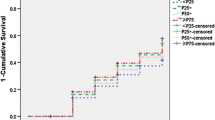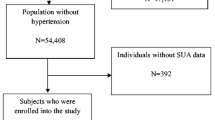Abstract
Evidence is lacking about the role of serum uric acid (SUA) in the progression from prehypertension to hypertension. Herein, we aimed to investigate the association of both baseline and dynamic change in SUA with the risk of hypertension developing from prehypertension. The study enrolled 11,488 participants with prehypertension during 2006–2010 from the Kailuan study. Change in SUA was assessed as % change of SUA from 2006 (baseline) to 2010. Participants were categorized into four groups by quartiles of baseline and change in SUA, separately. Multivariable logistic regressions were used to calculation the odds ratio (OR) and 95% confidence interval (CI). During a median follow-up of 7.06 years, 2716 (23.64%) participants developed hypertension from prehypertension. In the multivariable-adjusted model, the OR for hypertension comparing participants in the highest versus the lowest quartile of baseline SUA were 1.18 (95% CI, 1.02–1.36). Increased SUA over time was also associated with elevated risk of hypertension (OR in the highest quartile was 1.41 [95% CI, 1.23–1.62] versus the lowest quartile), especially in those with baseline SUA ≥ median (OR, 1.48; 95% CI, 1.21–1.81). Moreover, the addition of SUA to a conventional risk model had an incremental effect on the predictive value for hypertension (integrated discrimination improvement 0.30%, P < 0.0001; category-free net reclassification improvement 12.36%, P < 0.0001). Both high initial SUA and increased SUA over time can independently predict the progression from prehypertension to hypertension. Strategies aiming at controlling SUA level in prehypertensive subjects may impede the onset of hypertension.



Similar content being viewed by others
Data availability
Data are available to researchers on request for purposes of reproducing the results or replicating the procedure by directly contacting the corresponding author.
Code availability
Code are available to researchers on request for purposes of reproducing the results or replicating the procedure by directly contacting the corresponding author.
References
Chobanian AV, Bakris GL, Black HR, Cushman WC, Green LA, Izzo JL Jr., et al. The seventh report of the Joint National Committee on prevention, detection, evaluation, and treatment of high blood pressure: the JNC 7 report. Jama. 2003;289:2560–72.
Black HR, Sica D, Ferdinand K, White WB. Eligibility and disqualification recommendations for competitive athletes with cardiovascular abnormalities: task force 6: hypertension: a scientific statement from the American Heart Association and the American College of Cardiology. Circulation. 2015;132:e298–302.
Zheng L, Sun Z, Zhang X, Xu C, Li J, Hu D, et al. Predictors of progression from prehypertension to hypertension among rural Chinese adults: results from Liaoning Province. Eur J Cardiovasc Prev Rehabil. 2010;17:217–22.
Jiang M, Gong D, Fan Y. Serum uric acid levels and risk of prehypertension: a meta-analysis. Clin Chem Lab Med. 2017;55:314–21.
Mills K, Bundy J, Kelly T, Reed J, Kearney P, Reynolds K, et al. Global disparities of hypertension prevalence and control: a systematic analysis of population-based studies from 90 countries. Circulation. 2016;134:441–50.
Johnson R, Bakris G, Borghi C, Chonchol M, Feldman D, Lanaspa M, et al. Hyperuricemia, acute and chronic kidney disease, hypertension, and cardiovascular disease: report of a scientific workshop organized by the National Kidney Foundation. Am J Kidney Dis: Off J Natl Kidney Found. 2018;71:851–65.
Saiz L, Gorricho J, Garjón J, Celaya M, Erviti J, Leache L. Blood pressure targets for the treatment of people with hypertension and cardiovascular disease. Cochrane database Syst Rev. 2018;7:CD010315.
Wang Y, Hu J, Qu P, Wang K, Yan Y, Chu C, et al. Association between urinary sodium excretion and uric acid, and its interaction on the risk of prehypertension among Chinese young adults. Sci Rep. 2018;8:7749.
Lee H, Yano Y, Cho S, Park J, Park S, Lloyd-Jones D, et al. Cardiovascular risk of isolated systolic or diastolic hypertension in young adults. Circulation. 2020;141:1778–86.
Yano Y, Stamler J, Garside D, Daviglus M, Franklin S, Carnethon M, et al. Isolated systolic hypertension in young and middle-aged adults and 31-year risk for cardiovascular mortality: the Chicago Heart Association Detection Project in Industry study. J Am Coll Cardiol. 2015;65:327–35.
Liu L, Gu Y, Li C, Zhang Q, Meng G, Wu H, et al. Serum uric acid is an independent predictor for developing prehypertension: a population-based prospective cohort study. J Hum hypertension. 2017;31:116–20.
Feig D, Johnson R. Hyperuricemia in childhood primary hypertension. Hypertension (Dallas, Tex: 1979). 2003;42:247–52.
Borghi C, Tubach F, De Backer G, Dallongeville J, Guallar E, Medina J, et al. Lack of control of hypertension in primary cardiovascular disease prevention in Europe: results from the EURIKA study. Int J Cardiol. 2016;218:83–8.
Booth J, Li J, Zhang L, Chen L, Muntner P, Egan B. Trends in prehypertension and hypertension risk factors in US adults: 1999–2012. Hypertension (Dallas, Tex: 1979). 2017;70:275–84.
Chen C, Yuan Z. Prevalence and risk factors for prehypertension and hypertension among adults in Central China from 2000–2011. Clin Exp hypertension (N. Y, N. Y: 1993). 2018;40:734–43.
Yu E, Hong K, Chun B. Incidence and risk factors for progression from prehypertension to hypertension: a 12-year Korean Cohort Study. J hypertension. 2020;38:1755–62.
Selassie A, Wagner C, Laken M, Ferguson M, Ferdinand K, Egan B. Progression is accelerated from prehypertension to hypertension in blacks. Hypertension (Dallas, Tex: 1979). 2011;58:579–87.
Kuwabara M, Hisatome I, Niwa K, Hara S, Roncal-Jimenez C, Bjornstad P, et al. Uric acid is a strong risk marker for developing hypertension from prehypertension: a 5-Year Japanese Cohort Study. Hypertension (Dallas, Tex: 1979). 2018;71:78–86.
Wu S, An S, Li W, Lichtenstein AH, Gao J, Kris-Etherton PM, et al. Association of trajectory of cardiovascular health score and incident cardiovascular disease. JAMA Netw Open. 2019;2:e194758.
Jin C, Chen S, Vaidya A, Wu Y, Wu Z, Hu FB, et al. Longitudinal change in fasting blood glucose and myocardial infarction risk in a population without diabetes. Diabetes Care. 2017;40:1565–72.
Wang A, Zhang Y, Li J, Zhao Q, Cao Y, Li J, et al. High SBP trajectories are associated with risk of all-cause death in general Chinese population. J hypertension. 2018;36:1299–305.
Pottel H, Delanaye P, Schaeffner E, Dubourg L, Eriksen BO, Melsom T, et al. Estimating glomerular filtration rate for the full age spectrum from serum creatinine and cystatin C. Nephrol Dial Transpl. 2017;32:497–507.
Institute S. Base SAS 9.4 Procedures Guide: Statistical Procedures, Cary, NC: SAS Institute Inc; 2015.
Lotufo PA, Baena CP, Santos IS, Bensenor IM. Serum uric acid and prehypertension among adults free of cardiovascular diseases and diabetes: baseline of the Brazilian Longitudinal Study of adult health (ELSA-Brasil). Angiology. 2016;67:180–6.
Wang Y, Hu JW, Qu PF, Wang KK, Yan Y, Chu C, et al. Association between urinary sodium excretion and uric acid, and its interaction on the risk of prehypertension among Chinese young adults. Sci Rep. 2018;8:7749.
Syamala S, Li J, Shankar A. Association between serum uric acid and prehypertension among US adults. J Hypertens. 2007;25:1583–9.
Sung KC, Byrne CD, Ryu S, Lee JY, Lee SH, Kim JY, et al. Baseline and change in uric acid concentration over time are associated with incident hypertension in large Korean Cohort. Am J Hypertens. 2017;30:42–50.
Ma H, Wang X, Guo X, Li X, Qi L, Li Y. Distinct uric acid trajectories are associated with different risks of incident hypertension in middle-aged adults. Mayo Clin Proc. 2019;94:611–9.
Kawamoto R, Ninomiya D, Kasai Y, Senzaki K, Kusunoki T, Ohtsuka N, et al. Baseline and changes in serum uric acid independently predict 11-year incidence of metabolic syndrome among community-dwelling women. J endocrinological Investig. 2018;41:959–68.
Perlstein T, Gumieniak O, Hopkins P, Murphey L, Brown N, Williams G, et al. Uric acid and the state of the intrarenal renin-angiotensin system in humans. Kidney Int. 2004;66:1465–70.
Kang D, Park S, Lee I, Johnson R. Uric acid-induced C-reactive protein expression: implication on cell proliferation and nitric oxide production of human vascular cells. J Am Soc Nephrology: JASN. 2005;16:3553–62.
Mazzali M, Hughes J, Kim Y, Jefferson J, Kang D, Gordon K, et al. Elevated uric acid increases blood pressure in the rat by a novel crystal-independent mechanism. Hypertension (Dallas, Tex: 1979). 2001;38:1101–6.
Klein B, Klein R, Lee K. Components of the metabolic syndrome and risk of cardiovascular disease and diabetes in Beaver Dam. Diabetes care. 2002;25:1790–4.
Kawamoto R, Kohara K, Tabara Y, Abe M, Kusunoki T, Miki T. Insulin resistance and prevalence of prehypertension and hypertension among community-dwelling persons. J atherosclerosis thrombosis. 2010;17:148–55.
Madero M, Rodríguez Castellanos F, Jalal D, Villalobos-Martín M, Salazar J, Vazquez-Rangel A, et al. A pilot study on the impact of a low fructose diet and allopurinol on clinic blood pressure among overweight and prehypertensive subjects: a randomized placebo controlled trial. J Am Soc Hypertension: JASH. 2015;9:837–44.
Johnson R, Sánchez-Lozada L, Mazzali M, Feig D, Kanbay M, Sautin Y. What are the key arguments against uric acid as a true risk factor for hypertension? Hypertension (Dallas, Tex: 1979). 2013;61:948–51.
Acknowledgements
We thank all study participants, their relatives, the members of the survey teams at the 11 regional hospitals of the Kailuan Medical Group; and the project development and management teams at the Beijing Tiantan Hospital and the Kailuan Group.
Funding
This work was supported by the National Natural Science Foundation of China (grant number 81773512), Beijing Municipal Administration of Hospitals Incubating Program (PX2020021), Beijing Excellent Talents Training Program (2018000021469G234), Young Elite Scientists Sponsorship Program by CAST (2018QNRC001), and National Key Research and Development Program of China (No. 2018YFC1312800 and 2018YFC1312801).
Author information
Authors and Affiliations
Corresponding authors
Ethics declarations
Conflict of interest
The authors declare no competing interests.
Additional information
Publisher’s note Springer Nature remains neutral with regard to jurisdictional claims in published maps and institutional affiliations.
Supplementary information
Rights and permissions
About this article
Cite this article
Tian, X., Wang, A., Zuo, Y. et al. Baseline and change in serum uric acid predict the progression from prehypertension to hypertension: a prospective cohort study. J Hum Hypertens 36, 381–389 (2022). https://doi.org/10.1038/s41371-021-00522-7
Received:
Revised:
Accepted:
Published:
Issue Date:
DOI: https://doi.org/10.1038/s41371-021-00522-7
- Springer Nature Limited




